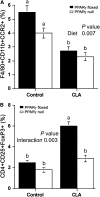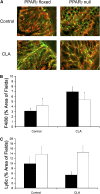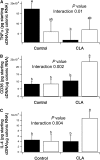Conjugated linoleic acid ameliorates inflammation-induced colorectal cancer in mice through activation of PPARgamma
- PMID: 20089779
- PMCID: PMC2821885
- DOI: 10.3945/jn.109.115642
Conjugated linoleic acid ameliorates inflammation-induced colorectal cancer in mice through activation of PPARgamma
Abstract
Conjugated linoleic acid (CLA) exerts a protective effect on experimental inflammatory bowel disease and shows promise as a chemopreventive agent against colorectal cancer (CRC) in mice, although the mechanisms by which it exerts its beneficial effects against malignancies in the gut are not completely understood. Mice lacking PPARgamma in immune and epithelial cells and PPARgamma-expressing littermates were fed either control or CLA-supplemented (1 g CLA/100 g) diets to determine the role of PPARgamma in inflammation-induced CRC. To induce tumor formation and colitis, mice were treated with azoxymethane and then challenged with 2% dextran sodium sulfate, respectively. Dietary CLA ameliorated disease activity, decreased colitis, and prevented adenocarcinoma formation in the PPARgamma-expressing floxed mice but not in the tissue-specific PPARgamma-null mice. Dietary CLA supplementation significantly decreased the percentages of macrophages in the mesenteric lymph nodes (MLN) regardless of the genotype and increased regulatory T cell numbers in MLN of PPARgamma-expressing, but not in the tissue-specific, PPARgamma-null mice. Colonic tumor necrosis factor-alpha mRNA expression was significantly suppressed in CLA-fed, PPARgamma-expressing mice. This study suggests CLA ameliorates colitis and prevents tumor formation in part through a PPARgamma-dependent mechanism.
Figures






Similar articles
-
Probiotic bacteria produce conjugated linoleic acid locally in the gut that targets macrophage PPAR γ to suppress colitis.PLoS One. 2012;7(2):e31238. doi: 10.1371/journal.pone.0031238. Epub 2012 Feb 21. PLoS One. 2012. PMID: 22363592 Free PMC article.
-
CLA-supplemented diet accelerates experimental colorectal cancer by inducing TGF-β-producing macrophages and T cells.Mucosal Immunol. 2019 Jan;12(1):188-199. doi: 10.1038/s41385-018-0090-8. Epub 2018 Oct 2. Mucosal Immunol. 2019. PMID: 30279515
-
Dietary conjugated linoleic acid activates PPARγ and the intestinal trefoil factor in SW480 cells and mice with dextran sulfate sodium-induced colitis.J Nutr. 2012 Dec;142(12):2135-40. doi: 10.3945/jn.112.163931. Epub 2012 Oct 17. J Nutr. 2012. PMID: 23077197
-
Dietary conjugated linoleic acid and n-3 polyunsaturated fatty acids in inflammatory bowel disease.Curr Opin Clin Nutr Metab Care. 2010 Sep;13(5):569-73. doi: 10.1097/MCO.0b013e32833b648e. Curr Opin Clin Nutr Metab Care. 2010. PMID: 20508519 Free PMC article. Review.
-
Conjugated linoleic acid metabolite impact in colorectal cancer: a potential microbiome-based precision nutrition approach.Nutr Rev. 2025 Feb 1;83(2):e602-e614. doi: 10.1093/nutrit/nuae046. Nutr Rev. 2025. PMID: 38728013 Free PMC article. Review.
Cited by
-
The Application of Metabolomics in Recent Colorectal Cancer Studies: A State-of-the-Art Review.Cancers (Basel). 2022 Jan 30;14(3):725. doi: 10.3390/cancers14030725. Cancers (Basel). 2022. PMID: 35158992 Free PMC article. Review.
-
Dietary fish oil reduces DNA adduct formation while estradiol upregulates apoptosis in response to DNA damage in the rat colon.Dig Dis Sci. 2011 Sep;56(9):2585-94. doi: 10.1007/s10620-011-1667-1. Epub 2011 Mar 16. Dig Dis Sci. 2011. PMID: 21409371
-
The role of T cell PPAR gamma in mice with experimental inflammatory bowel disease.BMC Gastroenterol. 2010 Jun 10;10:60. doi: 10.1186/1471-230X-10-60. BMC Gastroenterol. 2010. PMID: 20537136 Free PMC article.
-
Vitamin B12 coordinates ileal epithelial cell and microbiota functions to resist Salmonella infection in mice.J Exp Med. 2022 Jul 4;219(7):e20220057. doi: 10.1084/jem.20220057. Epub 2022 Jun 8. J Exp Med. 2022. PMID: 35674742 Free PMC article.
-
A novel variant on chromosome 6p21.1 is associated with the risk of developing colorectal cancer: a two-stage case-control study in Han Chinese.BMC Cancer. 2016 Oct 18;16(1):807. doi: 10.1186/s12885-016-2843-7. BMC Cancer. 2016. PMID: 27756247 Free PMC article.
References
-
- Jemal A, Siegel R, Ward E, Hao Y, Xu J, Murray T, Thun MJ. Cancer statistics, 2008. CA Cancer J Clin. 2008;58:71–96. - PubMed
-
- Ries LA, Melbert D, Krapcho M, Stinchcomb DG, Howlader N, Horner MJ, Mariotto A, Miller BA, Feuer EJ, et al. SEER Cancer Statistics Review, 1975–2005. Bethesda (MD): National Cancer Institute; 2008.
-
- Spunt S, Furman W, La Quaglia M, Bondy M, Goldberg R. Cancer epidemiology in older adolescents and young adults 15 to 29 years of age. In: SEER AYA monograph. Bethesda (MD): National Cancer Institute; 2008. p. 123–33.
-
- Munkholm P. Review article: the incidence and prevalence of colorectal cancer in inflammatory bowel disease. Aliment Pharmacol Ther. 2003;18 Suppl 2:1–5. - PubMed
Publication types
MeSH terms
Substances
Grants and funding
LinkOut - more resources
Full Text Sources
Medical
Molecular Biology Databases

